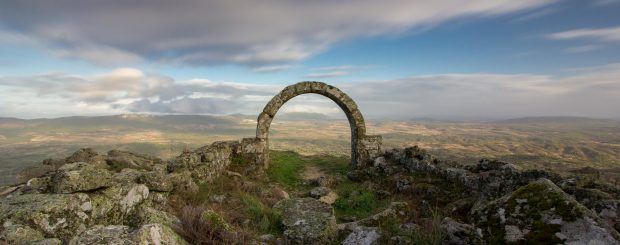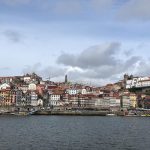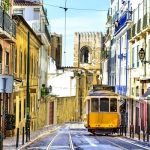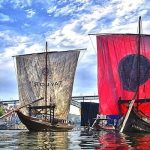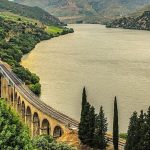5-day itinerary in the historic villages in Portugal, the perfect itinerary for those who already know Portugal, but want to know the historical villages between them; Almeida Belmonte, Piodão, Monsanto among others.
Not included
- Meals
- Entrance Fees
Included
- Accredited and exclusive guide
- Bottled water
- Free wifi
Prices
| 2 People – 1800€ | 6 People – 2400€ |
| 3 People – 1980€ | 7 People – 2550€ |
| 4 People – 2100€ | 8 People – 2800€ |
| 5 People – 2250€ |
5 day itinerary in historic villages in Portugal
Between 1994 and 2003 the 12 historic villages of Portugal were recognized, Almeida, Belmonte, Castelo Mendo, Castelo Novo, Castelo Rodrigo, Idanha-a-Velha, Linhares da Beira, Marialva, Monsanto, Piodao, Cortelha and Trancoso, chosen for their characteristics unique to its cultural matrix and its traditions.
Meet these villages between schists and granite, will be something you should visit in Portugal, getting to know the most characteristic villages and the Beirã culture.
Itinerary in historic villages in Portugal
High up in the mountains, far from prying eyes, its towering towers in its medieval castles, close to the border with Spain, where Kings and manors could rest quietly.
Moors, Christians, Castilians and Portuguese, they all tried to conquer them, leaving countless legends to tell, with all that Portugal has most authentic the authenticity of its people and the pride of a history with about 900 years.
In this itinerary we suggest visiting each of them on a route that begins in the only place where there is no castle to visit, Piodao in the confines of the Serra do Açor, and perhaps because of this it was not necessary to fortify it or build a Castle, which will end in Idanha-a-Velha, which keeps the ruins of ancient Egypt and the Visigothic cathedral
Take your questions now, contact us or enter our WhatsApp now…
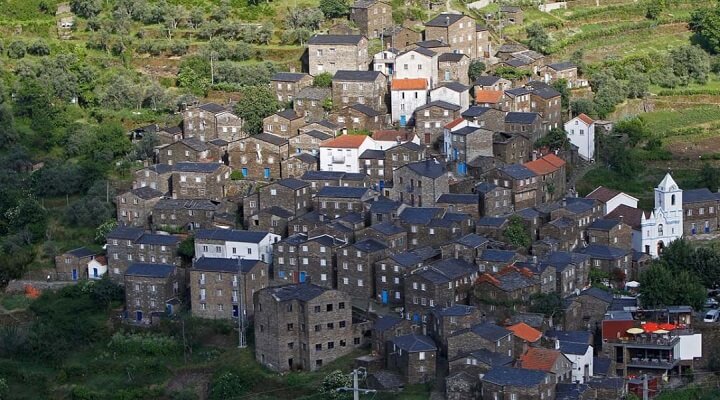
The first day of our itinerary in the historic villages in Portugal, starts in Lisbon or Oporto, from where we will leave early towards the village of Piodao , this beautiful village that looks more like a doll’s house, this is a small one found in the Serra do Açor, with schist houses painted with the color of the sky .
Taking a walk through the village, we will visit the statue of Canon Manuel Fernandes Nogueira, the promoter of the village and founder of the school that stayed here until the 1970s its “whiteness” in contrast to the dark color of the houses.
Stroll lightly between stairs, narrow streets and courtyards and stop to drink fresh, crystalline water at Fonte dos Algares, this beautiful shale fountain with the image of Lady Mary framed by a pointed arch. Imagine what the old mortuary chapel of Piodao would look like in the Chapel of Souls with a beautiful wooden altarpiece with a painting of Souls in Purgatory. After lunch we continue to Linhares.
Linhares known as the paragliding Portuguese capital, with it´s Castle built on a plateau at the top of its 809 meters and the Mondego River flowing at your feet with the crystalline water that comes from Serra da Estrela, we must not miss the Romanesque parish church boards attributed to Grao Vasco, an important 16th century painter.
Sit in the Forum and Dive Fountain built during the Roman period and used during the Middle Ages for meetings of the most important men in the village, to discuss issues of an administrative and judicial nature.
On this day we will reach Trancoso where we will spend the night and prepare the next day, do you know that there are about 15 locations in the world with the name of Trancoso among them Galicia, Brazil and even Mexico.
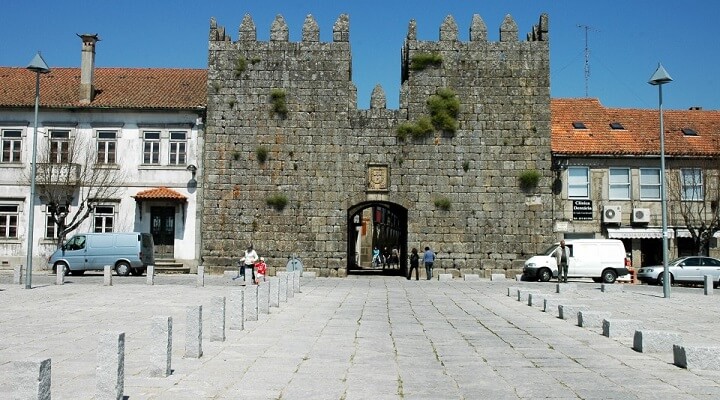
Our day will begin by getting to know a little better Trancoso , with its hot summers and rigorous winters, with a usual frost, where Túrdulos, Goths and Arabs, left their marks and who knows the name.
Entering the door of Él Rei, one of the four doors, we access the old Medieval village, connected to two towers and the coat of arms of Trancoso highlighted, in the whole we come across the statue of Bandarra in bronze, with a hammer and shoe and a sheet of paper on the side, instruments that have accompanied him all his life, this shoemaker who had hobbies; prophet and author of “As Trofas” who ended up condemned to death by the Inquisition.
Beresford the English Commander, that lived there during the French invasions, general who ended up decorated as first and last Count of Trancoso, towards the Castle passing in the Casa do Gato Preto, this beautiful property with extremely curious traces among them the Lion, the Tower, Pelican and the Sloth that leads us to attributes quite possibly Jewish, its name comes from a beam of the property that resembles the head of a cat.
We then arrived at the Castle with its five towers and a keep, with a quadrangular pyramid plan and a horseshoe-shaped opening.
Marialva, famous by the legend of the Lady of the Feet of the Goat, with traces of occupation from the Neolithic, the Túrdulos, Romans, Barbarians to even Muslims, until the intervention of the Order of the Templars, for the defense of the region together with other Castles in the region like Longroiva. Always connected to trade with a free fair since 1286, exempting merchants from paying taxes (toll) which attracted different merchants including Jews who ended up staying there.
Beginning our visit to the Temple House, an ancient Roman forum and temple dedicated to Jupiter, traces that ended up being used in the construction of the house, such as the columns, the cornice, here we can still find the Chapel of Nossa Senhora dos Remedios where several inscriptions were discovered Roman.
Wonderful Castelo Rodrigo inserted in the Iberian Meseta was a witness and apprentice of different peoples and cultures all full of battles, passion, revenge and betrayal that was born in Castro at the highest point by the Lusitanos, living on livestock and pastoral until the arrival of the Romans.
We enter the fortress, site of the old Castro towards the Clock Tower, this magnificent transition from turret to steeple, visiting the ruins of the Palace of Cristovao Moura, former Marquis of Castelo Rodrigo, arriving at the magnificent 16th century Pelourinho ordered to be built by Dom Manuel I, in the shape of a stylized cage, 8 meters high where they were a symbol of power and justice.
The Mother Church of the 18th century, founded by the Order of Hospitallers, whose mission is to care for the sick and pilgrims who pass through here on their way to Santiago de Compostela.
The Cistern, considered one of the most northern Muslim architectural evidence in the country where its horseshoe arch stands out, along with 13 meters deep and 63 steps, later used as a synagogue by Jews expelled from Castile.
Among several places to visit we hope to end the afternoon next to the Relogio do Sol, with a beautiful landscape in any of its cafes or restaurants, from here we will continue to Almeida.
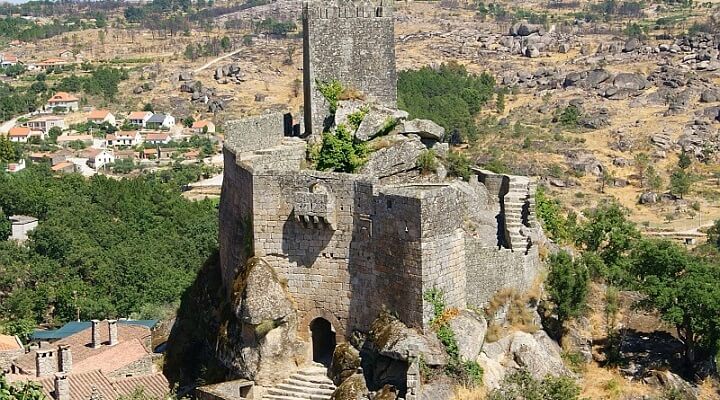
Almeida one of the most beautiful fortresses in the bastioned model, with a twelve-pointed star shape, six bastions and six revelins, surrounded by a moat, an underground magazine and pillboxes. Inside, we still find traces of the old Medieval Castle from the 13th century, of Arab origin.
In addition to several monuments, a house will hold our attention, the casa da roda, a house dedicated to unwanted newborns or bastards, the delivery of children was made anonymously and extremely quickly, left on a wooden wheel (now rebuilt in iron).
In Castelo Mendo two figures, Mendo and Menda, two petrified figures, facing each other, separated only by a street, keep the secrets of the village.
Even before entering the castle, the Alpendre das Feiras as well as the Chafariz dÉl Rei where the animals and marketers were refreshed before entering the fair, at the entrance of the village we have the Berrões or Verrancos, two zoomorphic sculptures of Indo-European origin used at the time to prevent animals from entering the castle, years later the population “decided” to behead them to allow the cattle to enter, as they continued to “terrify” the cattle.
Among several monuments to visit, the community oven will be one of them, of great importance to the community, it belonged to everyone and everyone could use it, a centuries-old tradition where women baked wood bread daily, there was a lady that helped those that didn’t know or had no way of kneading bread.
From Castelo Mendo we will continue to Sortelha and start our visit soon, Sortelha the village of the ring where until today, the knights by luck or courage try their luck to catch the ruby.
Here the human occupation started to start from the Iron Age, a Castro and a Roman village, which helped in the connection to the city of Guarda, however its importance grows with the Christian reconquest by desire of the Portuguese King Dom Sancho I that the people and builds the fortress (12th century).
A place with a lot to visit and to know, where we highlight its Castle in excellent conditions, built exclusively for military purposes and formed by two sets of walls at the end of the old town and the inner one that delimits the citadel enclosure, with the keep in clear evidence.
Feel the wind at Casa do Vento que Soa, a Beira house, try to find old treasures on Rua do Cofre, or seek consensus at Casa do Juiz, where the court of Cortelha was located, with direct stairs to the Church carved in the rock .
Next to Pelourinho the old house of the Chamber and Jail concentrated administrative, political and Judicial power, on the ground floor the jail, with its railing, on the upper floor the Chamber and the Court, where the coat of arms and Manueline sphere is still .

Today we will visit Belmonte, best known for the land of Pedro Alvaro Cabral, discoverer of Brazil and the Jews, since several expelled families arrived here from Castile, who in Belmonte initially settled in agriculture with the production of oil and wine and later in commerce.
Undoubtedly, the Jews had an extreme importance in the development of Belmonte, in 1496 Dom Manuel was obliged to create an edict that said that the Jews would have to become New Christians, which would end up completely changing the behavior of these families and eventually from the village, adopting a double life, on the street they were Christians, however at home they were Jews.
Our visit will start at the Jewish Museum, the first in Portugal, where we will get to know a little more about this culture and the importance of them in the region and in Portugal, we will also pay tribute to Pedro Alvares Cabral, this right next to the town hall until we went up to the Castle, built at the highest point where there would be old Castros.
Close by we have the Jewish Quarter and the Synagogue, in this neighborhood we can still identify outside some houses today, crosses on the threshold that served to identify that there would live Cristão-Novo, some of these houses still have characteristics of the time, with two doors, one for the other trade for the house.
We will then arrive at Monsanto, considered by many to be “the most Portuguese village in Portugal”, a recognition that is remembered by the silver cock at the top of the Lucano Tower, with traces of human occupation since the Paleolithic period, Monsanto was donated by D. Afonso Henriques (the first King of Portugal) ) to the Order of the Templars after their conquest from the Moors.
Its Castle at the highest point and made irregularly by the Templars, this to take advantage of the cliffs already exist, made it a Castle practically insurmountable, started by having 7 rectangular turrets, however some were destroyed and later the ruins used to repair the walls of the wall.
Located in a steep location, on the side of a hill, Monsanto is unique, a peaceful and authentic environment, here we will spend the night.
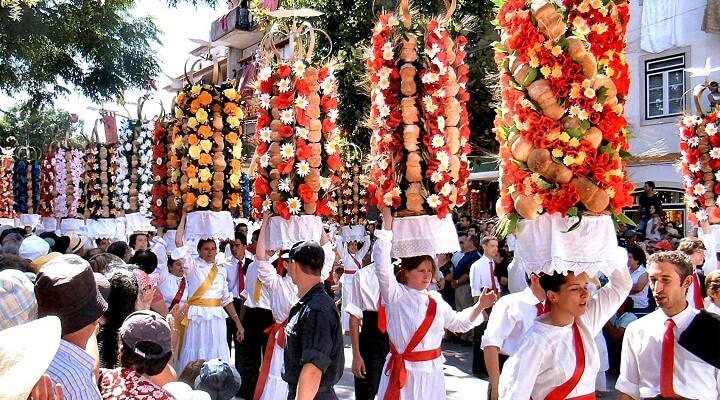
On the fifth day of our 5-day Itinerary in the historic villages in Portugal it is day to return to Lisbon, however we will visit Tomar,in what became known as the city of the Templars, the oldest part of the city (Medieval) oriented in cardinal points in a cross, with a convent in each of its ends in the center, Praça da Republica, with the Igreja Matriz, to the west the hill of the Castle and the Convent of Christ.
Countless traditional shops here you can also find the oldest cafe famous for its almond and chila cheese and the traditional Slices de Tomar, made only with egg yolks and cooked in a water bath in a very special pan, according to the legend invented by a coppersmith in the city in the mid-20th century.
Visit to the Church of Santa Maria do Olival, built in the 12th century and was the seat of the Order of the Templars in the country, with 3 naves was classified as a National Monument in 1910 and is one of the most emblematic examples of Gothic art in Portugal. Here is buried Gualdim Pais, founder of the city, and other grand masters of the Order, a Church that seems smaller than it really is since it is buried two meters below the ground.
The construction of Convento de Cristo begins with the Templar castle, at the forefront of medieval military architecture from the same period, the Romanesque Charola, inspired by the Church of the Holy Sepulcher in Jerusalem and which assumed the dual role of oratory and military watchtower. When the Military Order of the Temple was extinguished, D. Dinis, in Portugal, created the Military Order of Christ, who came to be heir to the goods, graces and privileges that had belonged to the Templars.
Our tour
Reviews Tripadvisor
 EXPERIÊNCIA SENSACIONAL EM PORTUGAL COM A WALKBORDER!!!
EXPERIÊNCIA SENSACIONAL EM PORTUGAL COM A WALKBORDER!!!
Eu e minha esposa tivemos o grande privilégio de fazermos OITO passeios maravilhosos com a equipe da WALKBORDER!
O Hugo, diretor... read more da WALKBORDER, nos foi indicado por um grande amigo, que nos disse que se gostaríamos de conhecer as “entre linhas” de Portugal, deveríamos contratar sua empresa! Assim foi feito, e foi realmente maravilhoso!!!
Fizemos dois passeios no Porto, dois em Lisboa, fomos à Coimbra, Nazaré, Óbidos, Sintra, Cascais, Estoril, Évora e Setúbal. Sem contar dois serviços de traslados que tivemos!
Qual o melhor? Injusto serei se fizer essa escolha. Cada lugar com sua paisagem, pessoas, comida, e até mesmo clima diferentes! Surpreendentemente como Portugal tem tanta diversidade com um território pequeno, se comparado ao Brasil.
Fomos atendidos por cinco diferentes profissionais da empresa, todos são brilhantes!
Nossos especiais agradecimentos aos guias Valter Madureira e Carlos Sousa que são excelentes profissionais, e ao Hugo que está sempre pronto para responder qualquer solicitação.
Certamente retornaremos com nossos filhos!

10 de January, 2022
 Nossa passagem por Óbidos, o almoço em Sintra e a visita ao Castelo da Penna foi maravilhosa. O Pedro foi um guia muito solícito e atencioso e as indicações... read more foram ótimas.
Nossa passagem por Óbidos, o almoço em Sintra e a visita ao Castelo da Penna foi maravilhosa. O Pedro foi um guia muito solícito e atencioso e as indicações... read more foram ótimas.

25 de April, 2022
Social Share
Best Sellers
2 Days Tour in Porto
2 Days Tour in Lisbon
Oporto Tour
Douro Valley Tour
Sobre
A Walkborder é uma agencia de viagens de Turismo Receptivo em Portugal , efetuamos topo o tipo de Transfers , Passeios Privados e Roteiros Privados.
Telefone: (+351) 963 666 009
Email: geral@tours.com.pt





